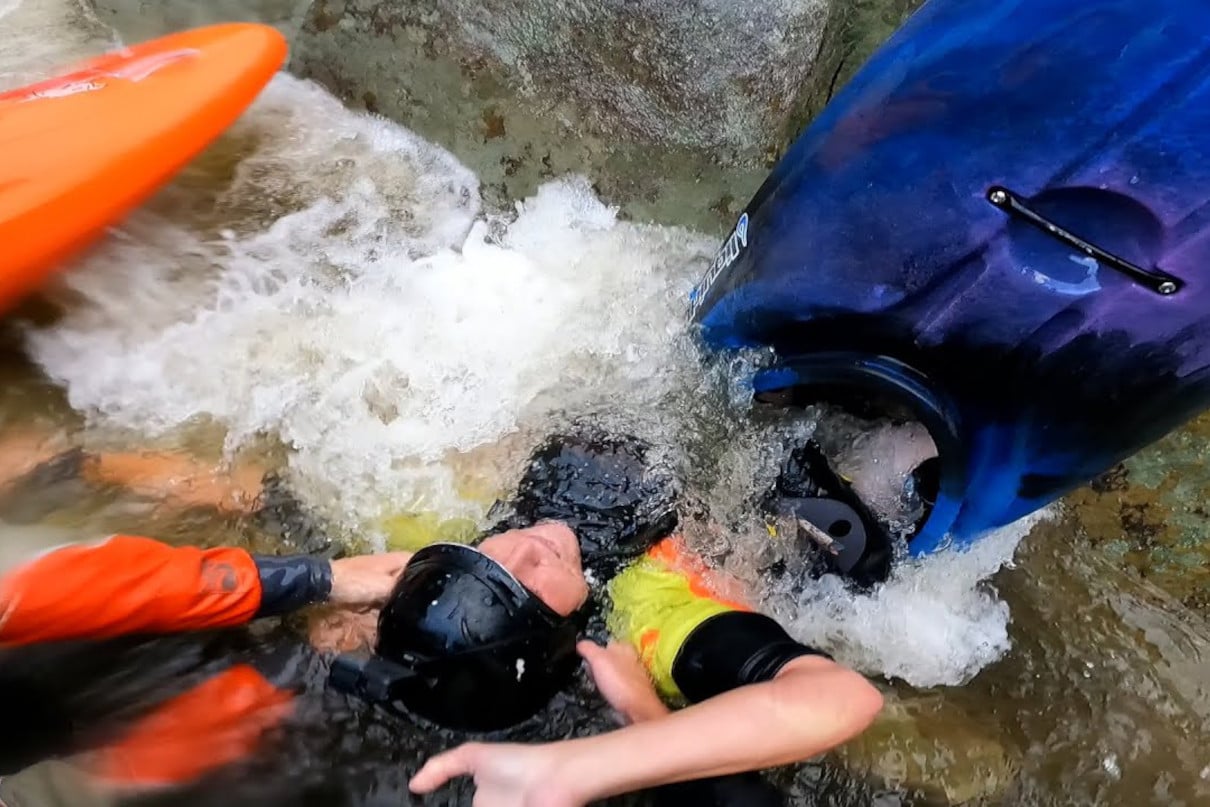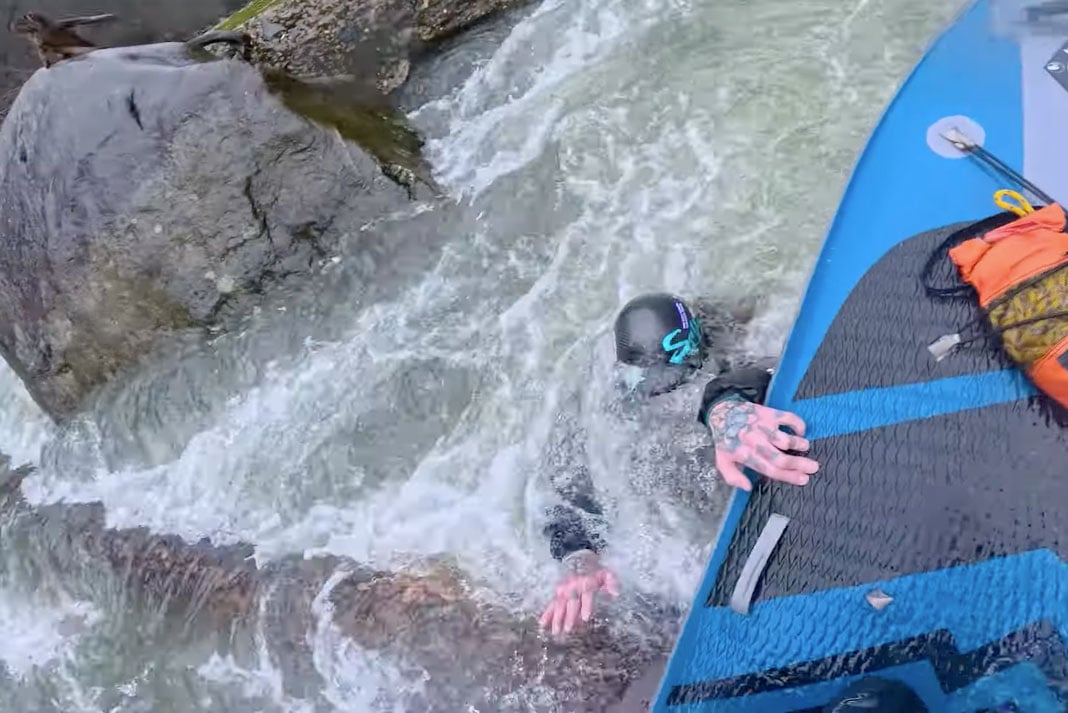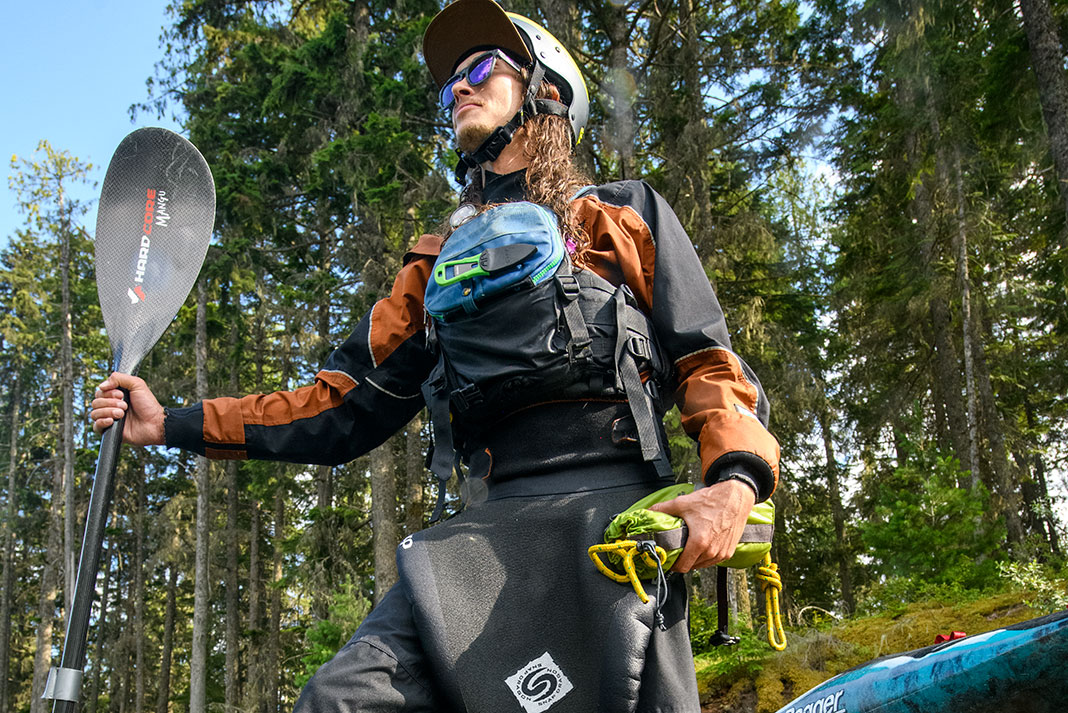[Editor’s note: The events in this video took place prior to 2024 Hurricane Helene.]
The Linville Gorge is one of the most impressive stretches of whitewater in the eastern United States. Seventeen miles of class V falling down the Blue Ridge Mountains of Western North Carolina at an average descent of 110 feet per mile. Through this stretch, the Linville River cascades over bedrock waterfalls and forces itself through cracks between huge boulders choking the riverbed.
The wilderness character of the Linville draws the desire of the most experienced whitewater paddlers. Meanwhile, the dangerous geology of the river continually demands respect no matter your ability. This humbling fact was shown firsthand in a rescue video recently published by Ben Atherton from an incident that took place in the fall of 2021.
“The one thing that saves people’s lives is getting your hands on them.”
Kayaker pinned in a siphon on the Linville Gorge
Atherton and his regular river running accomplice Josh Huber had rallied with a group for an after school lap down the Linville, which they had both run previously. In the video, we watch Huber enter Jailhouse rapid, a class IV+ drop according to American Whitewater.
“The middle of that rapid is a huge siphon, a jailhouse,” Atherton reflects on the incident and the fitting name for the precarious boulder garden. “Josh’s spot used to be good to go, but it had changed.”
As Atherton shares, Huber reaches a section of the rapid where it appears there is no clear path to exit. He is then pushed toward a corner which turns out to be a dangerous rock sieve, or in this case a siphon—a spot where the water flows under rocks like a funnel going who knows where before it eventually rejoins the rest of the river. The force of the current builds on the stern of Huber’s kayak, stands it up, and begins to push Huber under the rocks.

Against river and time
Within moments of Huber being pinned, his paddling partners Ben Atherton and Bernie Engelman are nearby to recognize the situation and act.
Engelman is still climbing out of his kayak as he grabs a hold of Huber’s lifejacket and reassures the paddler they’ve got him. Simultaneously Atherton leaves his kayak in a calm spot and wades out, reaching Huber and blasting his whistle.
“[Expletive] the whistle dude, we need to get him,” Engelman communicates to his fellow rescuer. Atherton’s whistle blasts to communicate with another paddler in their group are important, the equivalent of calling in backup. Engelman, however, recognizes the dire significance to having immediate contact with Huber before he’s pulled any deeper—complicating the effort.
“The one thing that saves people’s lives is getting your hands on them,” Atherton, who is also a kayak instructor, shares as he looks back at Huber’s rescue and his years of experience since. It’s a point he tries to get students to remember if nothing else when it comes to the reality of the scenario.
They quickly have Huber stabilized above the water, preventing him from drowning. Atherton and Engelman slow down their process and avoid breaking Huber’s leg as they extract him from the kayak.
A calm and composed rescue
All told, from the moment the paddler is entrapped in the siphon, to the time he is out of his kayak and standing is less than one minute—with barely a moment underwater.
“Yo, tell him I’m alive,” Huber tells his rescuers to communicate to the rest of their party as he’s standing waist-deep in the river. Then the reality of the situation flows from Huber’s tone as he repeats himself. “I’m [expletive] alive.”
“I was 17 and feeling invincible,” Atherton reflects on his perspective before his friend’s rescue. “That was the first time I’d ever seen something like that. I don’t even think it sunk in until years later.”
What stands out most in the rescue are the decisive actions and composure of the rescuers, and of Huber himself. They communicate clearly with each other and the entrapped, and do what is needed in the moment to save his life. Huber’s leg wasn’t broken but it was injured, and the rest of the paddle out became stressful knowing they were running out of sunlight with miles remaining in the gorge.
Never The Same River Twice
As old and permanent as rivers seem, they change regularly, big and small. A run like the Linville Gorge can see movement of rocks following even a modest high-water event. Atherton shares the rapids in the Linville Gorge are notorious for shifting. Slow-moving rivers can also see changing hazards like fallen trees from one day to the next. All the reason kayakers constantly survey stretches of river and monitor their paddling group.
The rescue video published by Atherton also took place before recent historic flooding ripped through Western North Carolina. In the time ahead, kayakers will begin to access classic stretches like the Linville. They’ll encounter sections of whitewater completely altered by the flood waters, and with it, entirely new hazards.





